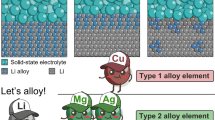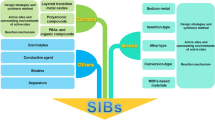Abstract
Recently, considerable improvements regarding the electrochemical performance of cathodes for lithium-ion batteries have been achieved by combining multiple lithium insertion compounds with complementary advantageous properties in one electrode. Herein, reversible heat generation rates of blended insertion electrodes are systematically investigated by temperature-dependent measurements of the equilibrium potential. The results are compared to theoretical predictions showing excellent agreement. Both the reversible heat profile and the corresponding dissipated heat significantly depend on the type and mass ratio of the constituents of the blend. The results indicate that reversible heat profiles of blended electrodes can be tailored to a certain extent by the targeted compilation of the active material mixture.





Similar content being viewed by others
References
Chikkannanavar SB, Bernardi DM, Liu L (2014) A review of blended cathode materials for use in Li-ion batteries. J Power Sources 248:91–100
Heubner C, Liebmann T, Schneider M, Michaelis A (2018) Recent insights into the electrochemical behavior of blended lithium insertion cathodes: a review. Electrochim Acta 269:745–760
Albertus P, Christensen J, Newman J (2009) Experiments on and modeling of positive electrodes with multiple active materials for lithium-ion batteries. J Electrochem Soc 156(7):A606–A618
Gallagher KG, Kang S-H, Park SU, Han SY (2011) xLi2MnO3·(1−x)LiMO2 blended with LiFePO4 to achieve high energy density and pulse power capability. J Power Sources 196(22):9702–9707
Appiah WA, Park J, van Khue L, Lee Y, Choi J, Ryou MH, Lee YM (2016) Comparative study on experiments and simulation of blended cathode active materials for lithium ion batteries. Electrochim Acta 187:422–432
Whitacre JF, Zaghib K, West WC, Ratnakumar BV (2008) Dual active material composite cathode structures for Li-ion batteries. J Power Sources 177(2):528–536
Lee K-S, Myung S-T, Kim D-W, Sun YK (2011) AlF3-coated LiCoO2 and Li[Ni1/3Co1/3Mn1/3]O2 blend composite cathode for lithium ion batteries. J Power Sources 196(16):6974–6977
Tran HY, Täubert C, Fleischhammer M et al (2011) LiMn2O4 spinel/LiNi0.8Co0.15Al0.05O2 blends as cathode materials for lithium-ion batteries. J Electrochem Soc 158(5):A556–A561
Jeong SK, Shin JS, Nahm KS, Prem Kumar T, Stephan AM (2008) Electrochemical studies on cathode blends of LiMn2O4 and Li[Li1/15Ni1/5Co2/5Mn1/3O2]. Mater Chem Phys 111(2-3):213–217
Gao J, Manthiram A (2009) Eliminating the irreversible capacity loss of high capacity layered Li[Li0.2Mn0.54Ni0.13Co0.13]O2 cathode by blending with other lithium insertion hosts. J Power Sources 191(2):644–647
Lee ES, Manthiram A (2011) High capacity Li [Li0. 2Mn0. 54Ni0. 13Co0.13] O2–VO2 (B) composite cathodes with controlled irreversible capacity loss for lithium-ion batteries. J Electrochem Soc 158(1):A47–A50
Smith AJ, Smith SR, Byrne T, Burns JC, Dahn JR (2012) Synergies in blended LiMn2O4 and Li[Ni1/3Mn1/3Co1/3]O2 positive electrodes. J Electrochem Soc 159(10):A1696–A1701
Klein A, Axmann P, Wohlfahrt-Mehrens M (2016) Synergetic effects of LiFe0.3Mn0.7PO4–LiMn1.9Al0.1O4 blend electrodes. J Power Sources 309:169–177
Heubner C, Lämmel C, Schneider M, Michaelis A (2017) Temperature induced compositional redistribution in blended insertion electrodes. J Power Sources 344:170–175
Bandhauer TM, Garimella S, Fuller TF (2011) A critical review of thermal issues in lithium-ion batteries. J Electrochem Soc 158(3):R1
Maleki H, Deng G, Anani A et al (1999) Thermal stability studies of Li-ion cells and components. J Electrochem Soc 146(9):3224–3229
Spotnitz R, Franklin J (2003) Abuse behavior of high-power, lithium-ion cells. J Power Sources 113(1):81–100
Wang Q, Ping P, Zhao X et al (2012) Thermal runaway caused fire and explosion of lithium ion battery. J Power Sources 208:210–224
Bandhauer TM, Garimella S, Fuller TF (2014) Temperature-dependent electrochemical heat generation in a commercial lithium-ion battery. J Power Sources 247:618–628
Heubner C, Schneider M, Michaelis A (2016) Detailed study of heat generation in porous LiCoO2 electrodes. J Power Sources 307:199–207
Thomas KE, Newman J (2003) Heats of mixing and of entropy in porous insertion electrodes. J Power Sources 119–121:844–849
Bernardi D, Pawlikowski E, Newman J (1985) A general energy balance for battery systems. J Electrochem Soc 132(1):5–12
Gu WB, Wang CY (2000) Thermal-electrochemical modeling of battery systems. J Electrochem Soc 147(8):2910
Thomas KE, Bogatu C, Newman J (2001) Measurement of the entropy of reaction as a function of state of charge in doped and undoped lithium manganese oxide. J Electrochem Soc 148(6):A570–A575
Lu W, Belharouak I, Park SH, Sun YK, Amine K (2007) Isothermal calorimetry investigation of Li1+xMn2−yAlzO4 spinel. Electrochim Acta 52(19):5837–5842
Eddahech A, Briat O, Vinassa J-M (2013) Thermal characterization of a high-power lithium-ion battery: potentiometric and calorimetric measurement of entropy changes. Energy 61:432–439
Williford RE, Viswanathan VV, Zhang J-G (2009) Effects of entropy changes in anodes and cathodes on the thermal behavior of lithium ion batteries. J Power Sources 189(1):101–107
Viswanathan VV, Choi D, Wang D, Xu W, Towne S, Williford RE, Zhang JG, Liu J, Yang Z (2010) Effect of entropy change of lithium intercalation in cathodes and anodes on Li-ion battery thermal management. J Power Sources 195(11):3720–3729
Hong J, Maleki H, Al Hallaj S et al (1998) Electrochemical-calorimetric studies of lithium-ion cells. J Electrochem Soc 145(5):1489–1501
Al Hallaj S, Prakash J, Selman JR (2000) Characterization of commercial Li-ion batteries using electrochemical–calorimetric measurements. J Power Sources 87(1-2):186–194
Huang J, Li Z, Liaw BY, Wang Z, Song S, Wu N, Zhang J (2015) Entropy coefficient of a blended electrode in a lithium-ion cell. J Electrochem Soc 162(12):A2367–A2371
Ohzuku T, Kitagawa M, Hirai T (1990) Electrochemistry of manganese dioxide in lithium nonaqueous cell III. X-ray diffractional study on the reduction of spinel-related manganese dioxide. J Electrochem Soc 137(3):769–775
Heubner C, Schneider M, Michaelis A (2017) Reversible heat generation rates of blended insertion electrodes. J Solid State Electrochem 21(7):2109–2115
Heubner C, Liebmann T, Lämmel C, Schneider M, Michaelis A (2018) Deconvolution of cyclic voltammograms for blended lithium insertion compounds by using a model-like blend electrode. ChemElectroChem 5(3):425–428
Reimers JN, Dahn JR (1992) Electrochemical and in situ X-ray diffraction studies of lithium intercalation in LixCoO2. J Electrochem Soc 139(8):2091–2097
Reynier Y, Graetz J, Swan-Wood T, Rez P, Yazami R, Fultz B (2004) Entropy of Li intercalation in LixCoO2. Phys Rev B 70(17):174304
Kobayashi Y, Mita Y, Seki S, Ohno Y, Miyashiro H, Nakayama M, Wakihara M (2008) Configurational entropy of lithium manganese oxide and related materials, LiCryMn2−yO4 (y= 0, 0.3). J Electrochem Soc 155(1):A14–A19
Author information
Authors and Affiliations
Corresponding author
Rights and permissions
About this article
Cite this article
Liebmann, T., Heubner, C., Schneider, M. et al. Investigations on the reversible heat generation rates of blended Li-insertion electrodes. J Solid State Electrochem 23, 245–250 (2019). https://doi.org/10.1007/s10008-018-4127-4
Received:
Revised:
Accepted:
Published:
Issue Date:
DOI: https://doi.org/10.1007/s10008-018-4127-4




